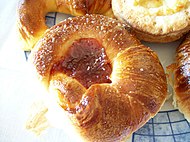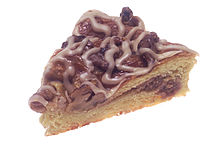| Revision as of 16:08, 17 February 2015 editSergeWoodzing (talk | contribs)Autopatrolled, Extended confirmed users, Pending changes reviewers, Rollbackers24,266 edits danish is priority word not spandauer← Previous edit | Revision as of 16:12, 17 February 2015 edit undoPeter Isotalo (talk | contribs)Autopatrolled, Extended confirmed users, Pending changes reviewers22,553 edits revert construction based on Swedish grammar ("wienerbröd av Spandauer-typ")Next edit → | ||
| Line 2: | Line 2: | ||
| | name = Danish pastry | | name = Danish pastry | ||
| | image = Glazed apple Danish.jpg | | image = Glazed apple Danish.jpg | ||
| | caption = A typical |
| caption = A typical Spandauer-type Danish with apple filling and glazing | ||
| | alternate_name = | | alternate_name = | ||
| | country = ] | | country = ] | ||
Revision as of 16:12, 17 February 2015
 A typical Spandauer-type Danish with apple filling and glazing A typical Spandauer-type Danish with apple filling and glazing | |
| Type | Sweet bread |
|---|---|
| Place of origin | Denmark |
| Main ingredients | Wheat flour, butter, milk, eggs, yeast. |
Danish pastry or just Danish (especially in American English) is a multilayered, laminated sweet pastry in the viennoiserie tradition. It was invented in Denmark and has since become a Danish specialty. Like other viennoiserie pastries, such as croissants, Danish pastry is a variant of puff pastry made of laminated yeast-leavened doughs, creating a layered texture.
Danish pastries were exported by immigrants to the United States, and are today popular around the world.
Composition
Danish pastry is made of yeast-leavened dough of wheat flour, milk, eggs, sugar and large amounts of butter or margarine.
A yeast dough is rolled out thinly, covered with thin slices of butter between the layers of dough, and then the dough is folded and rolled several times, creating 27 layers. If necessary, the dough is chilled between foldings to ease handling. The process of rolling, buttering, folding and chilling is repeated multiple times to create a multilayered dough that becomes airy and crispy on the outside, but also rich and buttery.
Butter is the traditional fat used in Danish pastry, but in industrial production, less expensive fats are often used, such as hydrogenated sunflower oil (known as "pastry fat" in the UK).
Terminology

In Danish and Norwegian the term for Danish pastry is wienerbrød, "Viennese bread". The same etymology is also the origin of the Finnish and and Swedish words for it.
Danish pastry is referred to as facturas in some Spanish speaking countries. In Vienna, the Danish pastry, referring to Denmark and Copenhagen, is called Kopenhagener Plunder or Dänischer Plunder.
History
The origin of the Danish pastry is often ascribed to a strike amongst bakery workers in Denmark in 1850. The strike forced bakery owners to hire workers from abroad, among them several Austrian bakers, who brought along new baking traditions and pastry recipes. The Austrian pastry of Plundergebäck, soon became popular in Denmark and after the labour disputes ended, Danish bakers adopted the Austrian recipes, adjusting them to their own liking and traditions by increasing the amount of egg and fat for example. This development resulted in what is now known as the Danish pastry.
One of the baking techniques and traditions that the Austrian bakers brought with them was the Viennese lamination technique. Due to such novelties the Danes called the pastry tecnique "wienerbrød" and, as mentioned above, that name is still in use in Northern Europe today. At that time, almost all baked goods in Denmark were given exotic names.
Danish pastry in Denmark

Danish pastries as consumed in Denmark have different shapes and names. Some are topped with chocolate, pearl sugar, glacé icing and/or slivered nuts and they may be stuffed with a variety of ingredients such as jam or preserves (usually apple or prune), remonce, marzipan and/or custard. Shapes are numerous, including circles with filling in the middle (known in Denmark as "Spandauers"), figure-eights, spirals (known as snails), and the pretzel-like kringles.
Varieties
In Sweden Danish pastry is typically made in the Spandauer-style, often with vanilla custard.
In the UK, various ingredients such as jam, custard, apricots, raisins, flaked almonds, pecans or caramelized toffee are placed on or within sections of divided dough, which is then baked. Cardamom is often added to increase the aromatic sense of sweetness.
In the US, Danishes are typically given a topping of fruit or sweet baker's cheese prior to baking. Danishes with nuts on them are also popular there and in Sweden, where chocolate spritzing and powdered sugar are also often added.
In Argentina, they are usually filled with dulce de leche or dulce de membrillo.
- Danish pastry in different countries
-
Several types of Danish pastry along with other baked goods in a bakery in Århus in Denmark
-
Pecan and maple Danish from France
-
 Argentinian facturas with dulce de membrillo
Argentinian facturas with dulce de membrillo
-
Danish pastries in the Philippines
Danish pastry in the United States

Danish pastry was brought to the United States by Danish immigrants. Lauritz C. Klitteng of Læsø popularized "Danish pastry" in the US around 1915–1920. According to Klitteng, he made Danish pastry for the wedding of President Woodrow Wilson in December 1915. Klitteng toured the world to promote his product and was featured in such 1920s periodicals as the National Baker, the Bakers' Helper, and the Bakers' Weekly. Klitteng briefly has his own Danish Culinary Studio at 146 Fifth Avenue in New York City.
Herman Gertner owned a chain of New York City restaurants and had brought Klitteng to New York to sell Danish pastry. Gertner's obituary appeared in the January 23, 1962 New York Times:
"At one point during his career Mr. Gertner befriended a Danish baker who convinced him that Danish pastry might be well received in New York. Mr. Gertner began serving the pastry in his restaurant and it immediately was a success."
See also
- Kringle
- Danish cookie
- Danish cuisine
- List of pastries
- Pan dulce (sweet bread)
- Doughnut
Notes
- "The patsies whose favourite pastries aren't really Danish". cphpost.dk. Retrieved 2015.
{{cite web}}: Check date values in:|accessdate=(help) - Cauvain & Young (2007), pp. 263—265
- Gisslen (2013), pp. 192—197
- ^ Rose Levy Beranbaum (1998). The Pie and Pastry Bible. Schribner. ISBN 0684813483.
- "global.britannica - Danish pastry". global.britannica.com. Retrieved 2015.
{{cite web}}: Check date values in:|accessdate=(help) - in Norway.
- and looks like In Finland is called viineri
- In Sweden it is called Wienerbrød
- Swedish wienerdröd
- "wienerbrod". www.dn.se. Retrieved 2015.
{{cite web}}: Check date values in:|accessdate=(help) - Ole Stig Andersen (Jun 26, 1995). "Hvor kommer brød fra". Politiken.
{{cite web}}: Missing or empty|url=(help) - "Wiener Plundergebäck" (PDF). Lebensministerium.
Je nach Fettmenge können Plunder mit mind. 300 g Fett pro 1000 g Grundteig und dänischer Plunder (Kopenhagener Plunder) mit mind. 600 g Fett pro 1000 g Grundteig unterschieden werden.
- "Wienerbrød". Arbejdsgiverforeningen Konditorer, Bagere og Chocolademagere. Retrieved 2012-01-17.
- Inger Abildgaard (1 February 2007). "De danske kager er en fantastisk historie". Samvirke (in Danish). Retrieved 16 October 2014.. Interview with Bi Skaarup, a Danish food-historian and former president of "Det Danske Gastronomiske Akademi" (lit.: The Danish Gastronomical Academy).
- "The patsies whose favourite pastries aren't really Danish". cphpost.dk. Retrieved 2015.
{{cite web}}: Check date values in:|accessdate=(help) - "You Call This Danish Pastry?". www.saveur.com. Retrieved 2015.
{{cite web}}: Check date values in:|accessdate=(help) - "Cheese Recipes: Bakers Cheese". Schmidling.com. Retrieved 2013-03-15.
- Hakon Mielche (1944). Jorden rundt med morgenbrød (in Danish). Hasselbalch.
References
- Cauvain, Stanley & Young, Linda S. (2007) Technology of Breadmaking. Springer Science & Business Media.
- Gisslen, Wayne (2013) Professional Baking. (6th edition) John Wiley & Sons, Hoboken, NJ. ISBN 9781118083741
External links
- Danish Pastry from food historian Barry Popik
- Danish pastry - base recipe - Danish pastry bar Kvalifood, a non-commercial educational cooking website from Denmark.
- BBC Danish pastries
- Danish